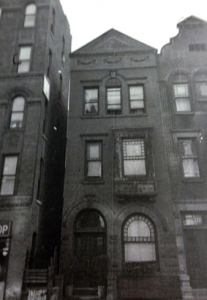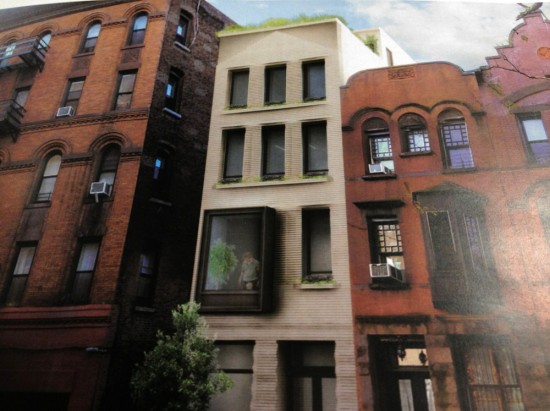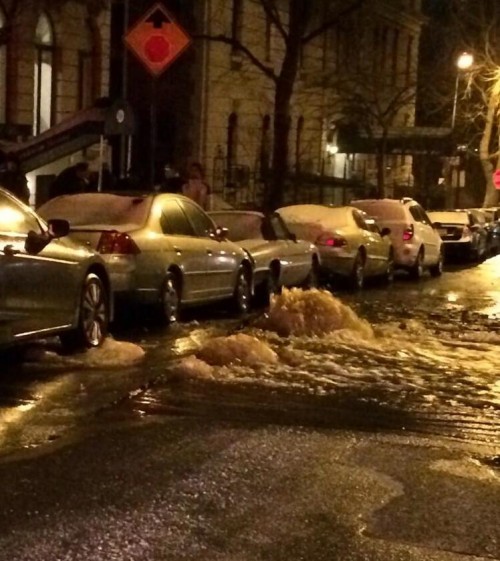The Landmarks Preservation Commission appears to be okay with a developer building a more modern townhouse on an historic block of the Upper West Side.
Commissioners encouraged architect Jordan Rogove to design a modern building at 110 West 88th street, a lot once occupied by a house built in 1886 (pictured below) that fell into disrepair and was torn down. That lot is in the Central Park West Historic District, so property owners need to seek LPC approval for changes.
“Don’t worry about what’s next door, just do what you want to do,” said Commissioner Joan Gerner, according to Curbed.
 Rogove’s design, pictured above, was rejected by the local community board “as being out of context with the neighborhood,” Curbed notes. Community board member Jay Adolph didn’t like the prominent bay window, which looks “like a Kindle.” It would feature four stories, plus a penthouse and a rooftop garden. The backyard would also get spruced up.
Rogove’s design, pictured above, was rejected by the local community board “as being out of context with the neighborhood,” Curbed notes. Community board member Jay Adolph didn’t like the prominent bay window, which looks “like a Kindle.” It would feature four stories, plus a penthouse and a rooftop garden. The backyard would also get spruced up.
But the landmark commissioners (who don’t have to listen to the community board’s recommendation) seemed to want the architect to make the building more modern, instead of trying to incorporate some old-style features and some newer ones.
It’s hard to envy the architect — he can’t easily match the original style, and a modern building could stick out like a sore thumb (another local townhouse project comes to mind).
As Commission Chairman Robert Tierney put it: “You got to a fork in the road, and, instead of taking it, as Yogi Berra said, you went both ways.”
Photos via Curbed.










when was original house demolished?
shame it was not restored and saved.
The architect at least tried to reference the adjacent buildings; the bay window has a precedent in the historic photo and in the adjacent building, the floor levels roughly align with the adjacent building, the masonry openings are close in size, and it looks from the rendering like there is intended to be a ghost of the original triangular pediment on the front facade just before the setback.
However, without any ornamentation at the lintels and pediment as it had historically, the styles falls flat. I agree that it isn’t quite successful at marrying modern and historic. It just looks blocky. I do, however, appreciate that it’s not an ugly glass or metal box, which is so popular these days.
My suggestion if the intent is to blend in with the surroundings, as it appears the architect attempted, would be to consider using a brownstone color building material (although I understand the contrast is meant to emphasize that this is not a historic building, and I appreciate the argument for that), and to replicate some of the ornamental details or at least a simplified version of them. Perhaps to delineate the new massing from the old, the upper floors could change building material, while the lower portions with the triangular pediment remain in the brownstone color.
A well chosen modern art piece can easily fit into any traditional setting. A glass or metal front might have been a better solution for this building. Painting the facade a bright color may even improve the current design. It is not absolutely necessary to match the surrounding architecture to have a good solution.
Lets all remember the community board’s have no enforcement ability, they can only make suggestions to city agencies. Things can be pushed or turned down at a community board and it makes no difference to its outcome
Community Boards aren’t always right and can be very subjective in their tastes. As political appointees by the Borough President and City Council, they were not elected, but have plenty of power to influence local policies. As an aesthetic revue board they probably are not the best arbiters of taste or design practices.
Re: “…Community board member Jay Adolph didn’t like the prominent bay window, which looks “like a Kindle.”
Ummm,it also sorta looks like those infamous windows in Amsterdam (Old Amsterdam, that is, not Grouchy Peg-Leg Pete Stuyvesant’s New Amsterdam) where ‘Ladies of the Night’ advertise their wares.
Wow…wotta great idea for a very-wealthy exhibitionist!
That’s what I like about the LPC preservation has nothing to do with what they do. In fact, preservation is so far from their thoughts that it is irrelevant. As to listening the the Community Board, why would they want to listen to them–they are only the Community and we know that the Community hasn’t mattered to city agencies for a long time.
It is possible to improve on historic buildings by greening the neighborhood. It looks like this one hosts a green roof and windows, which will help to improve air quality in our neighborhood and be aesthetically pleasing. Let’s be happy for the clean air that our children will be breathing on behalf of this addition.